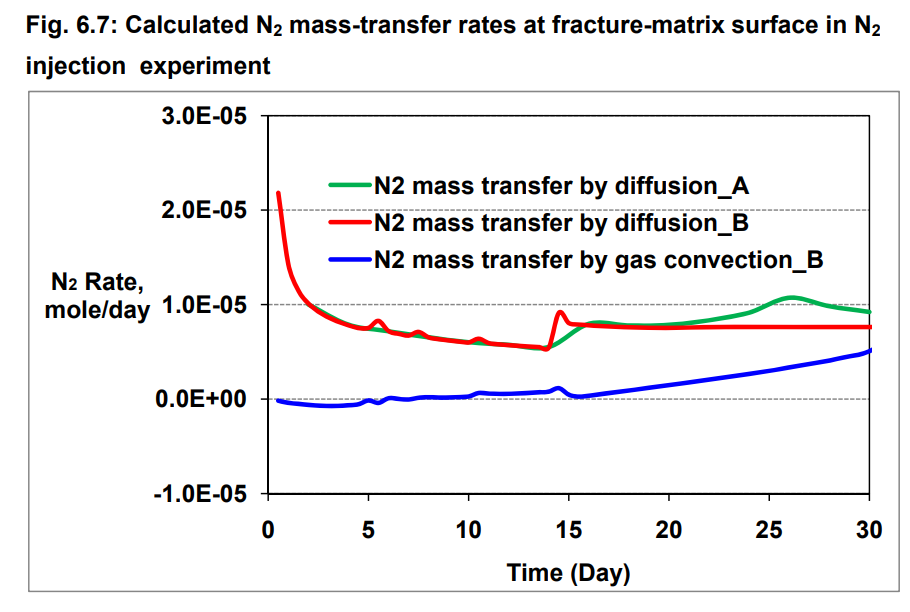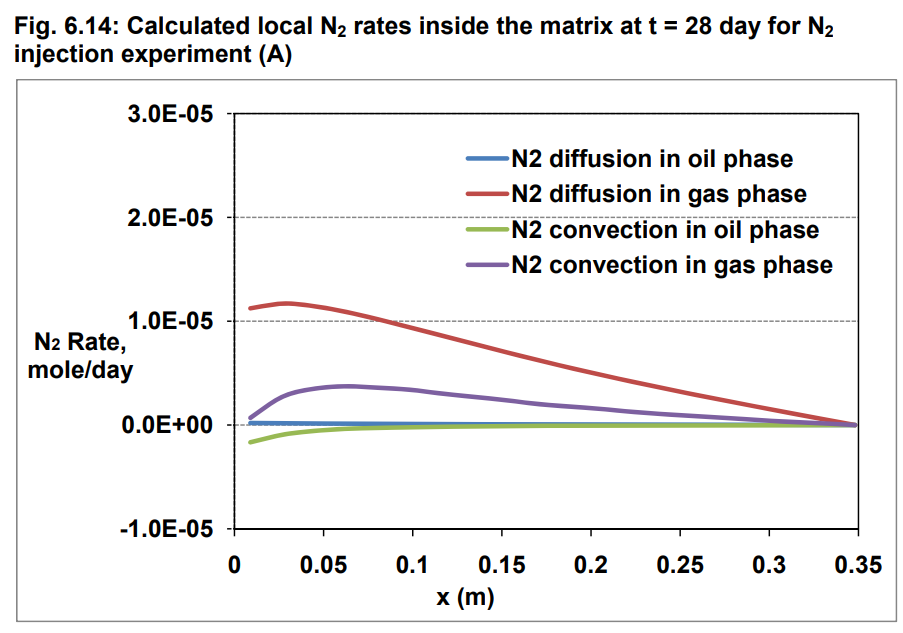Modeling effects of diffusion and gravity drainage on oil recovery
in naturally fractured reservoirs under gas injection
在裂缝性油藏注气开采中,重力驱替和裂缝 - 基质间传质对提高采收率至关重要,但裂缝 - 基质间传质机制研究有限。本文建立了描述裂缝中气体与水平基质块间传质的数学模型,考虑了气液两相中的扩散和对流,用 Peng - Robinson 状态方程计算相平衡组成。通过与 Morel 等(1990)和 Le Romancer 等(1994)的两组实验数据对比验证模型,结果表明模型能准确预测各组分采收率、饱和度剖面和基质 - 裂缝间压差。研究发现注气实验早期扩散是主要传质机制,后期气体对流作用增强;二氧化碳实验中扩散和对流均重要。二维模拟显示,缩放毛管压力与界面张力可促进二氧化碳从裂缝向基质扩散,提高重力驱替效果,扩散是基质 - 裂缝间主要传质机制,且网格尺寸越小,甲烷和戊烷采收率越高。
CMG 软件应用情况
在模型验证过程中,将本文模型与 CMG 的 GEM 组分模型针对一维和二维问题进行对比测试。在一维和二维算例中,分别构建了特定节点数量的单孔隙度模型,设定了相应的边界条件、储层岩石和流体属性等,并在相同的油藏条件下进行计算。通过对比 CMG 模型和本文模型在不同时间下各节点的压力、油饱和度、气饱和度等模拟结果,表明本文模型与 CMG 模型计算结果吻合良好,验证了本文模型的可靠性和有效性,同时也体现了 CMG 软件在油藏数值模拟研究中的重要参考价值,为本文模型的进一步优化和应用提供了对比基础。
作者:Ahmad Jamili 堪萨斯大学化学与石油工程系
Abstract
Gas injection in naturally fractured reservoirs maintains the reservoir pressure, and increases oil recovery primarily by gravity drainage and to a lesser extent by mass transfer between the flowing gas in the fracture and the porous matrix. Although gravity drainage has been studied extensively, there has been limited research on mass-transfer mechanisms between the gas flowing in the fracture and fluids in the porous matrix. This dissertation presents a mathematical model which describes the mass transfer between a gas flowing in a fracture and a horizontal matrix block. The model accounts for diffusion and convection mechanisms in both gas and liquid phases in the porous matrix. The injected gas diffuses into the porous matrix through gas and liquid phases causing the vaporization of oil in the porous matrix which is transported by convection and diffusion to the gas flowing in the fracture. Compositions of equilibrium phases are computed using the Peng-Robinson EOS.
The mathematical model was validated by comparing calculations to two sets of experimental data reported in the literature (Morel et. al. (1990) and Le Romancer et. al. (1994)), one involving nitrogen flow in the fracture and the second with carbon dioxide flow. The matrix was a chalk. The resident fluid in the porous matrix was a mixture of methane and pentane. In the nitrogen injection experiments, liquid and vapor phases were initially present, while in the carbon dioxide experiment the matrix was saturated with a liquid phase.
Calculated results match the experimental data, including recovery of each component, saturation profile, and pressure gradient between matrix and fracture. The simulation revealed the presence of countercurrent flow inside the block. Diffusion was the main mass-transfer mechanism between matrix and fracture during nitrogen injection. In the carbon dioxide experiment, diffusion and convection were both important. Studies in 2-D were conducted to investigate the effect CO2 on recovery from a matrix block. It was found that the scaling capillary pressure with interfacial tension increased CO2 from the fracture to the matrix and therefore enhanced gravity drainage from the matrix block. Diffusion was the main recovery mechanism between matrix and fracture.



